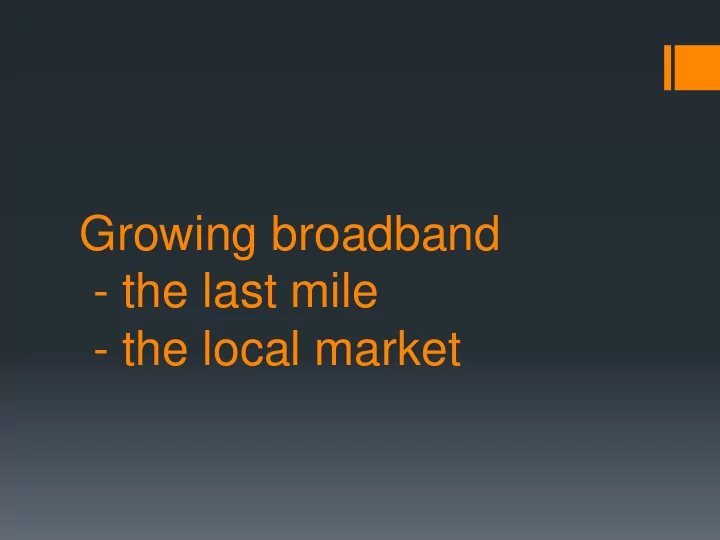

Growing broadband - the last mile - the local market
From middle mile to last mile
Benefits of a Middle Mile Network Connects between communities with a high capacity fiber network Links anchor institutions like schools, hospitals, government offices, etc. Often provides a competitive marketplace reducing the cost of wholesale broadband services for local ISPs THE CHALLENGE: Bringing the benefits of the middle mile network to the remaining last mile customers
Desired Outcomes Attract a private sector service provider to build FTTH to the entire community Attract a private sector service provider to extend fiber to key business locations in the community, such as an industrial park or downtown area Build a targeted or ubiquitous public sector – owned network Operate as a utility Operate as an open access network
Attracting providers Make your community a more vibrant tech marketplace (Sharon’s presentation) Document demand (targeted or communitywide) Surveys Social media campaigns Business focus groups GIS maps Reduce provider costs Dig once conduit/fiber installation Favorable fiber / conduit lease rates “Meet me room” in a public sector building Google community checklist
Examples
City of Eagan – Access Eagan Fiber Began with “Dig Once” conduit development Built fiber to meet its own and county government needs Six telecom providers have leased City of Eagan fiber to serve local business customers moving them from T1s to Gb www.accesseagan.com
Northeast Service Cooperative
Northeast Service Cooperative Middle Mile - Minnesota School cooperative received ARRA Stimulus grant to connect Anchor Institutions across much of northeast Minnesota, a very rural place Frontier Communications leased fiber from NESC as a way to upgrade their entire network within the region This made high speed Internet services possible to Frontier customers who were close to the Frontier CO’s This backbone will enable Frontier to maximize the benefits of CAF2 funding for residential customers NESC provides the backbone for use by the Fond du Lac Band of Lake Superior Chippewa to use for their USDA Community Connect project
Itasca County Seeking Broadband One half of 3,000 square mile county served by a rural telephone cooperative using FTTH to offer Gigabit services One half served by a large LEC offering nothing in the rural countryside County used: Surveys Social media Local broadband champions GIS mapping To convince Paul Bunyan Communications to expand into at least two additional townships (72 square miles) using state broadband funds.
The Cooperatives Model RS Fiber is a new broadband cooperative in south central Minnesota Formed by area leaders, assisted by existing farmers’ cooperative and electric cooperative Covers ten communities and 17 rural townships Local units of government are lending funds to the cooperative Cooperatives are private sector, but have different objectives than publicly traded firms. Benefits accrue to members, not shareholders allowing more patient investments
Growing the local market
Blandin Foundation Rural philanthropy dedicated to rural economic development and leadership Engaged on the broadband issue for more than ten years Received ARRA grant for Sustainable Broadband Adoption Worked with over 30 “communities” over the past six years to spur broadband adoption using the Intelligent Community model
Intelligent Community Framework KNOWLEDGE� INNOVATION � B M WORKFORCE � R A O R A K D E B T� A I N N DIGITAL� INCLUSION � D � G �
Community Process Planning Benchmarking Vision / Desired Outcomes / Project Development Project funding Project implementation Projects Training (community and business) Wi-Fi Hot Spots Tech centers Social Media Breakfasts/Tech Networking Groups Tele-health apps Community marketing Lots more! Findings 15% faster growth in take rates in our communities More, small projects have higher impact than few, large projects Cross – sector projects have higher impact Fund activity, not equipment
Blandin Foundation broadband.blandinfoundation.org blandinonbroadband.org Bill Coleman bill@communitytechnologyadvisors.com 651-491-2551 communitytechnologyadvisors.com
Recommend
More recommend